Set query context
The query context gives you fine-grained control over how Apache Druid executes your individual queries. While the default settings in Druid work well for most queries, you can set the query context to handle specific requirements and optimize performance.
Common use cases for the query context include:
- Override default timeouts for long-running queries or complex aggregations.
- Debug query performance by disabling caching during testing.
- Configure SQL-specific behaviors like time zones for accurate time-based analysis.
- Set priorities to ensure critical queries get computational resources first.
- Adjust memory limits for queries that process large datasets.
The way you set the query context depends on how you submit the query to Druid, whether using the web console or API. It also depends on whether your query is Druid SQL or a JSON-based native query. This guide shows you how to set the query context for each application.
Before you begin, identify which context parameters you need to configure in order to establish your query context as query context carriers. For available parameters and their descriptions, see Query context reference.
Web console
You can configure query context parameters for both Druid SQL and native queries in the web console.
The following steps show you how to set the query context using the web console:
-
In the web console, select Query from the top-level navigation.
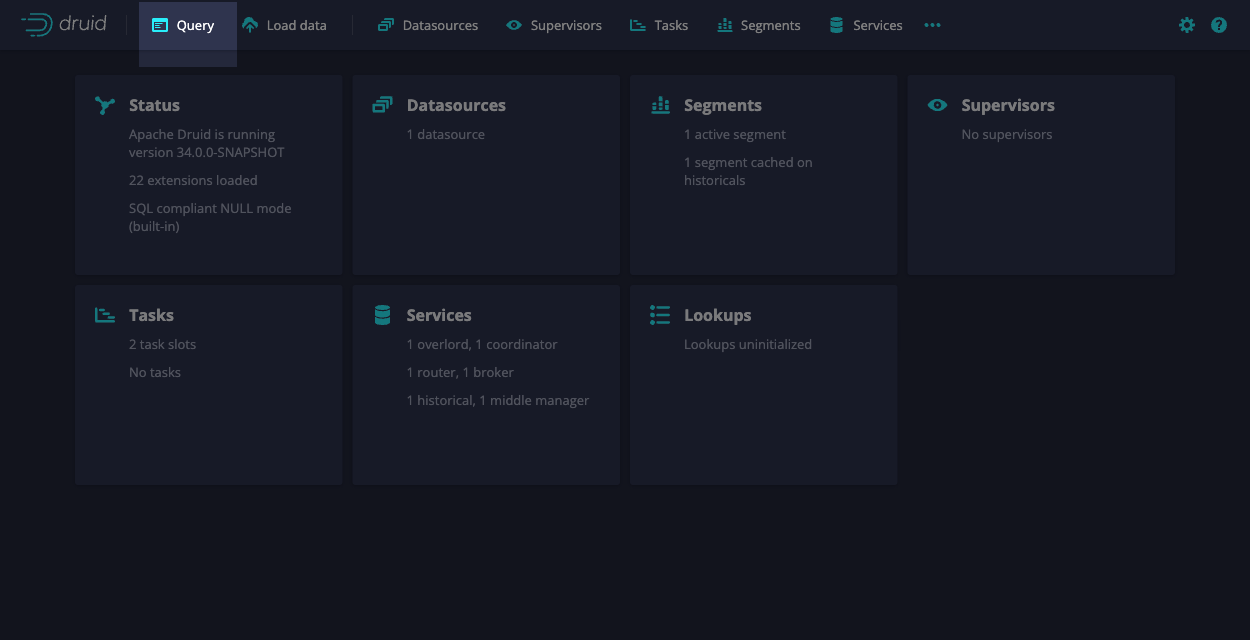
-
Enter the query you want to run. If you ingested the Wikipedia dataset from the quickstart, you can use the following query:
SELECT * FROM wikipedia WHERE user='BlueMoon2662'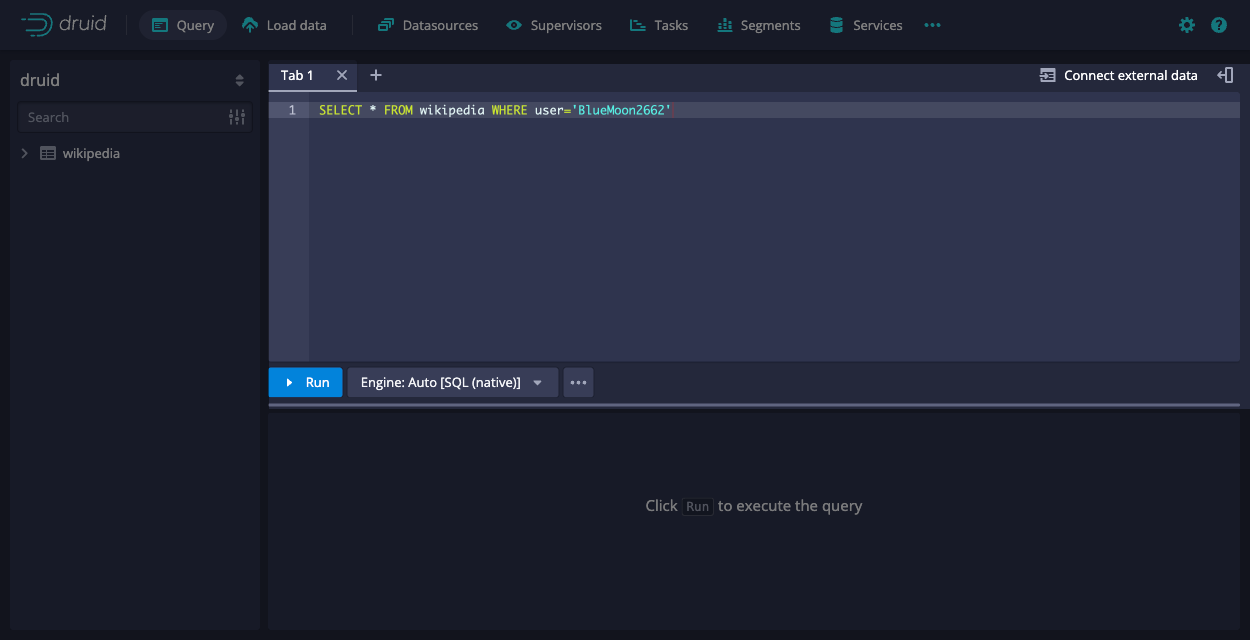
-
In the menu for the engine selector, click Edit query context.
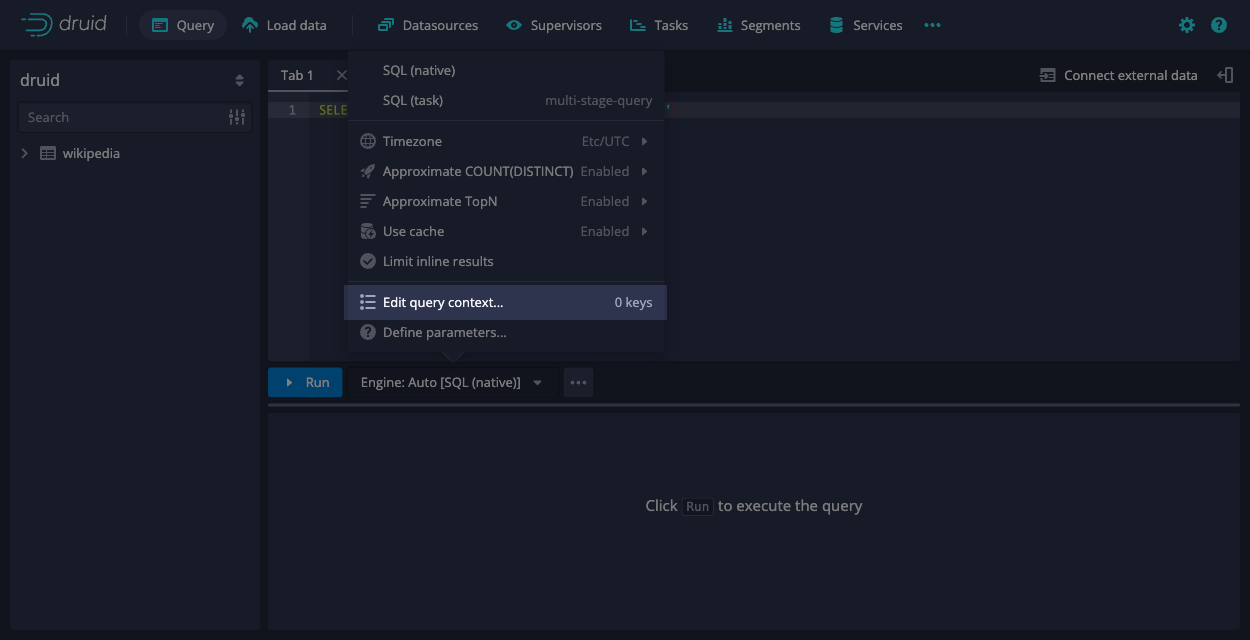
-
In the Edit query context dialog, add your context parameters as JSON key-value pairs.
For example, you can set the
sqlTimeZoneparameter to ensure that the query results reflect the specified time zone. This may differ from your local time zone when viewing the data.{
"sqlTimeZone" : "America/Los_Angeles"
} -
The web console validates the JSON object containing the query context parameters and highlights any syntax errors. Click Save.
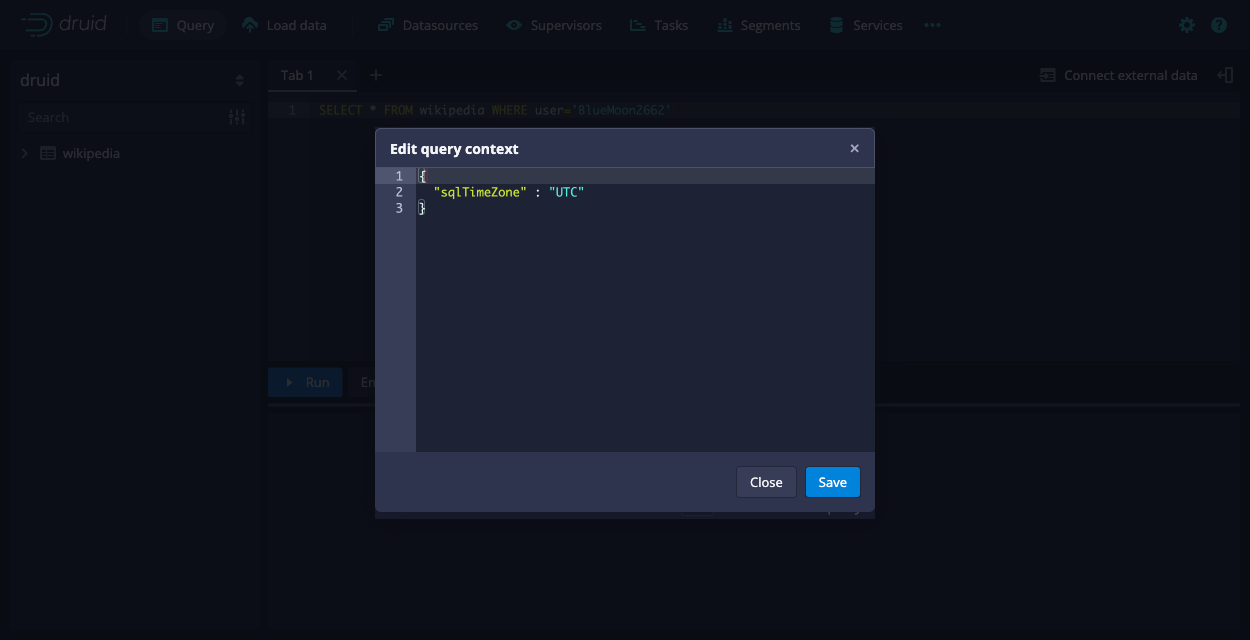
-
Click Run to execute your query with the specified context parameters.
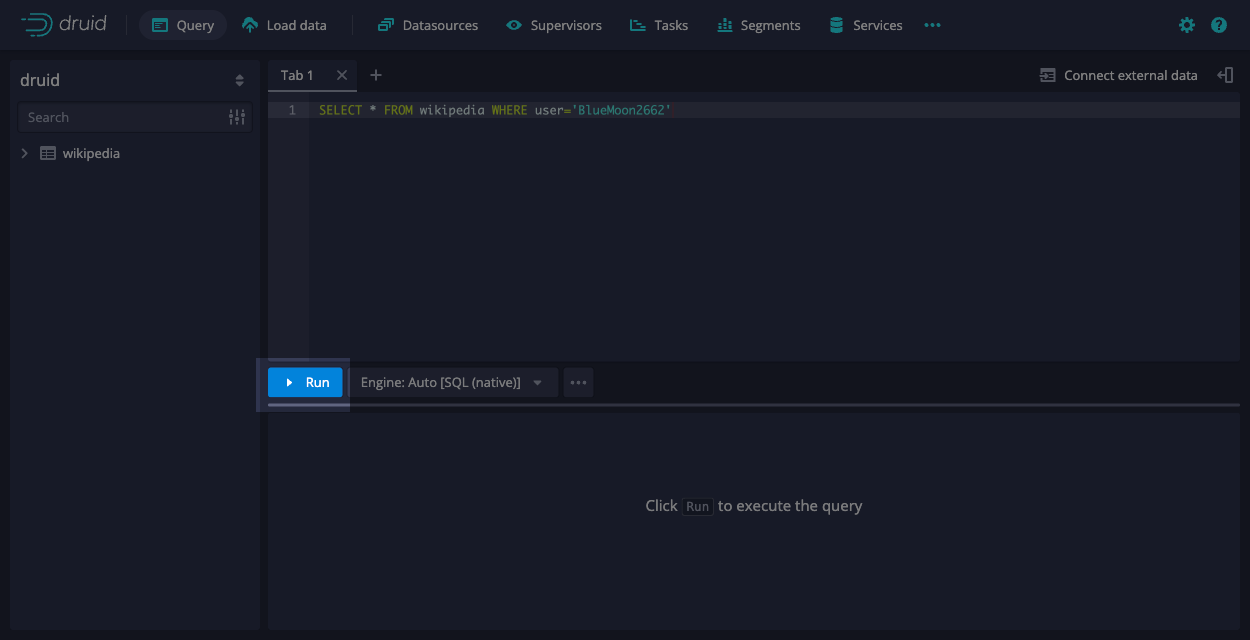
Compare the results of the example query with and without the query context.
- Without the query context, the query returns the
__timevalue of2015-09-12T00:47:53.259Z. - When you set the
sqlTimeZoneparameter, the query returns2015-09-11T17:47:53.259-07:00.
- Without the query context, the query returns the
Druid SQL
When using Druid SQL programmatically—such as in applications, automated scripts, or database tools—you can set the query context through various methods depending on how you submit your queries.
HTTP API
When using the HTTP API, you include query context parameters in the context object of your JSON request. For more information on how to format Druid SQL API requests and handle responses, see Druid SQL API.
The following example sets the sqlTimeZone parameter:
{
"query": "SELECT * FROM wikipedia WHERE user = 'BlueMoon2662'",
"context": {
"sqlTimeZone": "America/Los_Angeles"
}
}
You can set multiple context parameters in a single request:
{
"query": "SELECT * FROM wikipedia WHERE user = 'BlueMoon2662'",
"context": {
"sqlTimeZone": "America/Los_Angeles",
"sqlQueryId": "request01"
}
}
JDBC driver API
You can connect to Druid over JDBC and issue Druid SQL queries using the Druid SQL JDBC driver API. This approach is useful when integrating Druid with BI tools or Java applications. When connecting to Druid through JDBC, you set query context parameters in a JDBC connection properties object. You supply the object when establishing the connection to Druid.
The following code excerpt shows how you can configure the connection properties:
String url = "jdbc:avatica:remote:url=http://localhost:8888/druid/v2/sql/avatica/";
// Set the time zone to America/Los_Angeles
Properties connectionProperties = new Properties();
connectionProperties.setProperty("sqlTimeZone", "America/Los_Angeles");
try (Connection connection = DriverManager.getConnection(url, connectionProperties)) {
// create and execute statements, process result sets, etc
}
View full JDBC example
import java.sql.*;
import java.util.Properties;
public class JdbcDruid {
public static void main(String args[]) {
// Connect to /druid/v2/sql/avatica/ on your Broker.
String url = "jdbc:avatica:remote:url=http://localhost:8888/druid/v2/sql/avatica/;transparent_reconnection=true";
// The query you want to run.
String query = "SELECT * FROM wikipedia WHERE user = 'BlueMoon2662'";
// Set any connection context parameters you need here.
Properties connectionProperties = new Properties();
connectionProperties.setProperty("sqlTimeZone", "America/Los_Angeles");
try (Connection connection = DriverManager.getConnection(url, connectionProperties)) {
try (
final Statement statement = connection.createStatement();
final ResultSet rs = statement.executeQuery(query)
) {
while (rs.next()) {
// process result set
Timestamp timeStamp = rs.getTimestamp("__time");
System.out.println(timeStamp);
}
}
} catch (Exception e) {
System.out.println(e.toString());
}
}
}
SET statements
You can use the SET command to specify SQL query context parameters that modify the behavior of a Druid SQL query. Druid accepts one or more SET statements before the main SQL query. The SET command works in the both web console and the Druid SQL HTTP API.
In the web console, you can write your SET statements followed by your query directly. For example:
SET sqlTimeZone = 'America/Los_Angeles';
SELECT * FROM wikipedia WHERE user = 'BlueMoon2662';
You can also include your SET statements as part of the query string in your HTTP API call. For example:
curl -X POST 'http://localhost:8888/druid/v2/sql' \
-H 'Content-Type: application/json' \
-d '{
"query": "SET sqlTimeZone='\''America/Los_Angeles'\''; SELECT * FROM wikipedia WHERE user='\''BlueMoon2662'\''"
}'
You can also combine SET statements with the context field. If you include both, the parameter value in SET takes precedence:
curl -X POST 'http://localhost:8888/druid/v2/sql' \
-H 'Content-Type: application/json' \
-d '{
"query": "SET sqlTimeZone='\''America/Los_Angeles'\''; SELECT * FROM wikipedia WHERE user='\''BlueMoon2662'\''",
"context": {
"sqlTimeZone": "UTC"
}
}'
For more details on how to use the SET command in your SQL query, see SET.
You cannot use SET statements in JDBC connections.
Native queries
For native queries, you can include query context parameters in a JSON object named context within your query or through the web console.
The following example shows a native query that sets the sqlTimeZone to America/Los_Angeles and queryId to only_query_id_test:
{
"queryType": "timeseries",
"dataSource": "wikipedia",
"granularity": "day",
"descending": true,
"filter": {
"type": "and",
"fields": [
{ "type": "selector", "dimension": "countryName", "value": "Australia" },
{ "type": "selector", "dimension": "isAnonymous", "value": "true" }
]
},
"aggregations": [
{ "type": "count", "name": "row_count" }
],
"intervals": ["2015-09-12T00:00:00.000/2015-09-13T00:00:00.000"],
"context": {
"sqlTimeZone": "America/Los_Angeles",
"queryId": "only_query_id_test",
}
}
Runtime properties
You can configure query context parameters globally by adding a runtime property to your configuration file. The property takes the following format:
druid.query.default.context.{PARAMETER}={VALUE}
Replace PARAMETER with the query context parameter and VALUE with its value.
For example:
druid.query.default.context.debug=true
For more information, see Configuration reference.
Query context precedence
For a given context query, Druid determines the final query context value to use based on the following order of precedence, from lowest to highest:
-
Built-in defaults: Druid uses the documented default values if you don’t specify anything.
-
Runtime properties: If you configure parameters as
druid.query.default.context.{PARAMETER}in the configuration files, these override the built-in defaults and act as your system-wide defaults. -
Context object in HTTP request: Parameters passed within the JSON
contextobject override both built-in defaults and runtime properties. -
SET statements: Parameters set in Druid SQL using
SET key=value;take the highest precedence and override all other settings.
Learn more
For more information, see the following topics:
- Query context reference for available query context parameters.
- SQL query context for SQL-specific context parameters.
- Multi-stage query context for context parameters specific to SQL-based ingestion.
- Native queries for details on constructing native queries with context.
- SET for complete syntax and usage of SET statements.